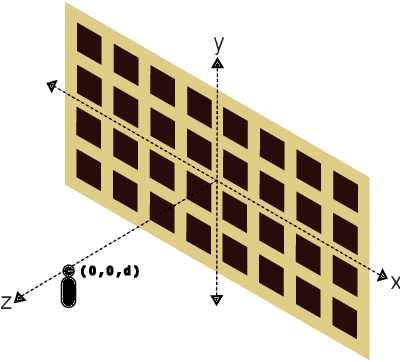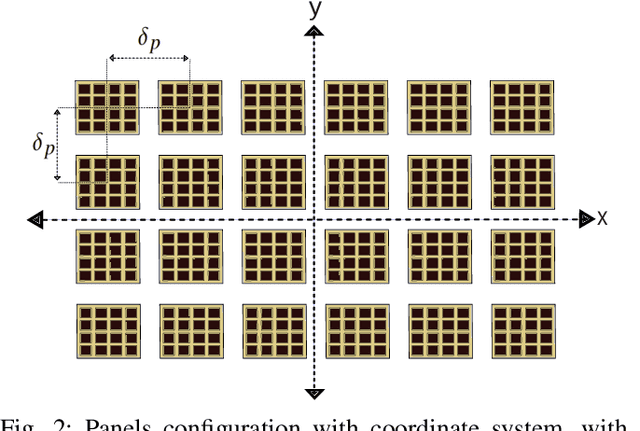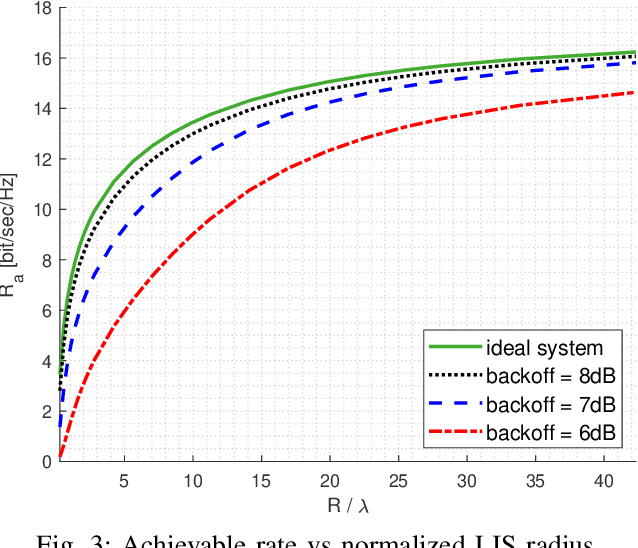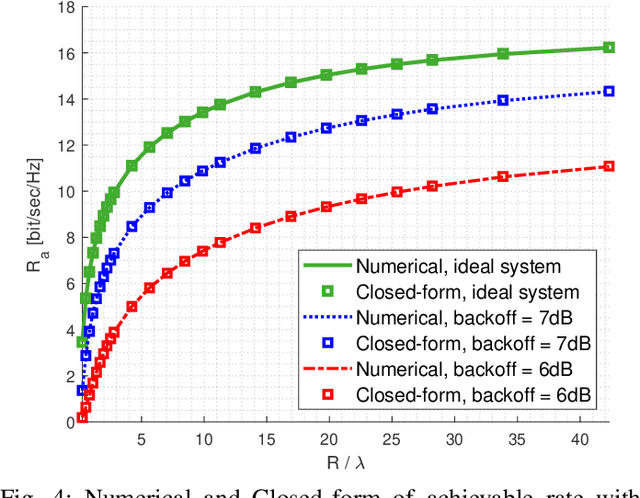Juan Vidal Alegría
Dimensionally-Efficient Transmission and Storage of Unitary Matrices
Oct 06, 2025



Abstract:Unitary matrices are the basis of a large number of signal processing applications. In many of these applications, finding ways to efficiently store, and even transmit these matrices, can significantly reduce memory and throughput requirements. In this work, we study the problem of efficient transmission and storage of unitary matrices. Specifically, we explicitly derive a dimensionally-efficient parametrization (DEP) for unitary matrices that allows identifying them with sequences of real numbers, where the dimension coincides with the dimension of the unitary group where they lie. We also characterize its inverse map that allows retrieving the original unitary matrices from their DEP. The proposed approach effectively allows halving the dimension with respect to naively considering all the entries of each unitary matrix, thus reducing the resources required to store and transmit these matrices. Furthermore, we show that the sequence of real numbers associated to the proposed DEP is bounded, and we delimit the interval where these numbers are contained, facilitating the implementation of quantization approaches with limited distortion. On the other hand, we outline ways to further reduce the dimension of the DEP when considering more restrictive constraints for matrices that show up in certain applications. The numerical results showcase the potential of the proposed approach in general settings, as well as in three specific applications of current interest for wireless communications research.
Decentralized Multi-Antenna Architectures with Unitary Constraints
Jan 10, 2025Abstract:The increase in the number of base station (BS) antennas calls for efficient solutions to deal with the increased interconnection bandwidth and processing complexity of traditional centralized approaches. Decentralized approaches are thus gaining momentum, since they achieve important reductions in data/processing volume by preprocessing the received signals before forwarding them to a central node. The WAX framework offers a general description of decentralized architectures with arbitrary interplay between interconnection bandwidth and decentralized processing complexity, but the applicability of this framework has only been studied assuming unrestricted baseband processing. We consider an adaptation of the WAX framework where the decentralized processing has unitary restriction, which allows for energy-efficient implementations based on reconfigurable impedance networks at the cost of some performance loss. Moreover, we propose an effective method to minimize the performance gap with respect to centralized processing. The previous method gives a first step towards characterizing the information-lossless trade-off between interconnection bandwidth and processing complexity in decentralized architectures with unitary constraints.
Spectrum Efficiency and Processing Latency Trade-offs in Panel-Based LIS
Nov 28, 2024



Abstract:The next generation wireless systems will face stringent new requirements, including ultra-low latency, high data rates and enhanced reliability. Large Intelligent Surfaces, is one proposed solution that has the potential to solve these high demands. The real-life deployment of such systems involves different design considerations with non-trivial trade-offs. This paper investigates the trade-off between spectral efficiency and processing latency, considering different antenna distribution schemes and detection algorithms. A latency model for the physical layer processing has been developed with realistic hardware parameters. The simulation results using an in-door environment show that distributing the antennas throughout the scenario improves the overall reliability, while the impact on the latency is limited when zero-forcing (ZF) detection is used. On the other hand, changing the detection algorithm to maximum-ratio combining (MRC) may reduce the latency significantly, even if a larger number of antennas are needed to achieve a similar spectrum efficiency as ZF detection.
Large Intelligent Surfaces with Low-End Receivers: From Scaling to Antenna and Panel Selection
Nov 07, 2024



Abstract:We analyze the performance of large intelligent surface (LIS) with hardware distortion at its RX-chains. In particular, we consider the memory-less polynomial model for non-ideal hardware and derive analytical expressions for the signal to noise plus distortion ratio after applying maximum ratio combining (MRC) at the LIS. We also study the effect of back-off and automatic gain control on the RX-chains. The derived expressions enable us to evaluate the scalability of LIS when hardware impairments are present. We also study the cost of assuming ideal hardware by analyzing the minimum scaling required to achieve the same performance with a non-ideal hardware. Then, we exploit the analytical expressions to propose optimized antenna selection schemes for LIS and we show that such schemes can improve the performance significantly. In particular, the antenna selection schemes allow the LIS to have lower number of non-ideal RX-chains for signal reception while maintaining a good performance. We also consider a more practical case where the LIS is deployed as a grid of multi-antenna panels, and we propose panel selection schemes to optimize the complexity-performance trade-offs and improve the system overall efficiency.
Over-the-Air DPD and Reciprocity Calibration in Massive MIMO and Beyond
Nov 07, 2024Abstract:In this paper we study an over-the-air (OTA) approach for digital pre-distortion (DPD) and reciprocity calibration in massive multiple-input-multiple-output systems. In particular, we consider a memory-less non-linearity model for the base station (BS) transmitters and propose a methodology to linearize the transmitters and perform the calibration by using mutual coupling OTA measurements between BS antennas. We show that by only using the OTA-based data, we can linearize the transmitters and design the calibration to compensate for both the non-linearity and non-reciprocity of BS transceivers effectively. This allows to alleviate the requirement to have dedicated hardware modules for transceiver characterization. Moreover, exploiting the results of the DPD linearization step, our calibration method may be formulated in terms of closed-form transformations, achieving a significant complexity reduction over state-of-the-art methods, which usually rely on costly iterative computations. Simulation results showcase the potential of our approach in terms of the calibration matrix estimation error and downlink data-rates when applying zero-forcing precoding after using our OTA-based DPD and calibration method.
Channel Orthogonalization in Panel-Based LIS
May 03, 2024Abstract:Large intelligent surface (LIS) has gained momentum as a potential 6G-enabling technology that expands the benefits of massive multiple-input multiple-output (MIMO). On the other hand, orthogonal space-division multiplexing (OSDM) may give a promising direction for efficient exploitation of the spatial resources, analogous as what is achieved with orthogonal frequency-division multiplexing (OFDM) in the frequency domain. To this end, we study how to enforce channels orthogonality in a panel-based LIS scenario. Our proposed method consists of having a subset of active LIS-panels coherently serving a set of users, and another subset of LIS-panels operating in semi-passive mode by implementing a receive and re-transmit (RRTx) process. This results in an inter-symbol interference (ISI) channel, where we characterize the semi-passive processing required to achieve simultaneous orthogonality in time and space. We then employ the remaining degrees of freedom (DoFs) from the orthogonality constraint to minimize the semi-passive processing power, where we derive a closed-form global minimizer, allowing for efficient implementation of the proposed scheme.
Channel Orthogonalization with Reconfigurable Surfaces: General Models, Theoretical Limits, and Effective Configuration
Mar 22, 2024Abstract:We envision a future in which multi-antenna technology effectively exploits the spatial domain as a set of non-interfering orthogonal resources, allowing for flexible resource allocation and efficient modulation/demodulation. Reconfigurable intelligent surface (RIS) has emerged as a promising technology which allows shaping the propagation environment for improved performance. This paper studies the ability of three extended types of reconfigurable surface (RS), including the recently proposed beyond diagonal RIS (BD-RIS), to achieve perfectly orthogonal channels in a general multi-user multiple-input multiple-output (MU-MIMO) scenario. We propose practical implementations for the three types of RS consisting of passive components, and obtain the corresponding restrictions on their reconfigurability. We then use these restrictions to derive closed-form conditions for achieving arbitrary (orthogonal) channels. We also study the problem of optimal orthogonal channel selection for achieving high channel gain without active amplification at the RS, and we propose some methods with satisfying performance. Finally, we provide efficient channel estimation and RS configuration techniques such that all the computation, including the channel selection, may be performed at the base station (BS). The numerical results showcase the potential and practicality of RS channel orthogonalization, thus taking a step towards orthogonal spatial domain multiplexing (OSDM).
Trade-Offs in Decentralized Multi-Antenna Architectures: Sparse Combining Modules for WAX Decomposition
Sep 08, 2023Abstract:With the increase in the number of antennas at base stations (BSs), centralized multi-antenna architectures have encountered scalability problems from excessive interconnection bandwidth to the central processing unit (CPU), as well as increased processing complexity. Thus, research efforts have been directed towards finding decentralized receiver architectures where a part of the processing is performed at the antenna end (or close to it). A recent paper put forth an information-lossless trade-off between level of decentralization (inputs to CPU) and decentralized processing complexity (multiplications per antenna). This trade-off was obtained by studying a newly defined matrix decomposition--the WAX decomposition--which is directly related to the information-lossless processing that should to be applied in a general framework to exploit the trade-off. {The general framework consists of three stages: a set of decentralized filters, a linear combining module, and a processing matrix applied at the CPU; these three stages are linear transformations which can be identified with the three constituent matrices of the WAX decomposition. The previous work was unable to provide explicit constructions for linear combining modules which are valid for WAX decomposition, while it remarked the importance of these modules being sparse with 1s and 0s so they could be efficiently implemented using hardware accelerators.} In this work we present a number of constructions, as well as possible variations of them, for effectively defining linear combining modules which can be used in the WAX decomposition. Furthermore, we show how these structures facilitate decentralized calculation of the WAX decomposition for applying information-lossless processing in architectures with an arbitrary level of decentralization.
* 16 pages, 6 figures, accepted for publication at IEEE Transactions on Signal Processing
 Add to Chrome
Add to Chrome Add to Firefox
Add to Firefox Add to Edge
Add to Edge